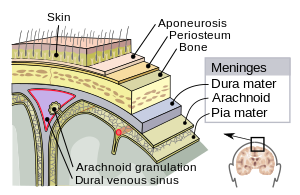Spontaneous cerebrospinal fluid leak
| Spontaneous cerebrospinal fluid leak | |
|---|---|
 |
|
| The spinal meninges of the central nervous system. The dura mater and arachnoid mater hold in CSF and are impacted by SCSFLS. | |
| Classification and external resources | |
| Specialty | neurology |
| ICD-10 | G96.0, G97.0 |
| ICD-9-CM | 339.8, 348.4, 349.0, 792.0 |
| MedlinePlus | 001068 |
Spontaneous cerebrospinal fluid leak syndrome (SCSFLS) is a medical condition in which the cerebrospinal fluid (CSF) held in and around the human brain and spinal cord leaks out of the surrounding protective thecal or dural sac of the dura, for no apparent reason. The dura, a tough, inflexible tissue, is the outermost of the three layers of the meninges, the system of membranes surrounding the brain and spinal cord.
A spontaneous cerebrospinal fluid leak is one of several types of cerebrospinal fluid leaks and occurs due to the presence of one or more holes in the dura. A spontaneous CSF leak, as opposed to traumatically caused CSF leaks, arises idiopathically. A loss of CSF greater than its rate of production leads to a decreased volume inside the skull known as intracranial hypotension. A CSF leak is most often characterized by orthostatic headaches — headaches that worsen in a vertical position and improve when lying down. Other symptoms can include neck pain or stiffness, nausea, vomiting, dizziness, fatigue, and a metallic taste in the mouth (indicative of a cranial leak). A CT scan can identify the site of a cerebrospinal fluid leakage. Once identified, the leak can often be repaired by an epidural blood patch, an injection of the patient's own blood at the site of the leak, a fibrin glue injection or surgery.
SCSFLS afflicts 5 out of every 100,000 people. On average, the condition is developed at the age of 42, and women are twice as likely as men to develop the condition. Some people with SCSFLS chronically leak cerebrospinal fluid despite repeated attempts at patching, leading to long-term disability due to pain. SCSFLS was first described by German neurologist Georg Schaltenbrand in 1938 and by American physician Henry Woltman of the Mayo Clinic in the 1950s.
...
Wikipedia
